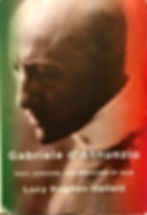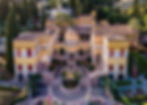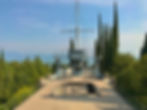Gabriele D'Annunzio: Book Review
- Mike
- Mar 26, 2024
- 5 min read
Updated: May 1, 2024
I first read this biography by Lucy Hughes-Hallett in 2014, soon after its publication, when my knowledge and understanding of Italy was still nascent and I was not equipped to properly assess the merit and rationale of many of the arguments and positions put forward by the author. After re-reading the book recently with the benefit of ten years in Italy living with an Italian wife and having Italian in-laws, there are now certain things with which I take issue.

First let me state however that it remains for me a thoroughly entertaining and well-written biography of one of Italy’s most colorful and controversial characters that encompasses also the most turbulent period in the history of Italy as a nation, from unification in the 1860s to the height of fascist power in the 1930s.
The author sets out her stall as early as the second page of the very first chapter when she takes a typically non-Italian view of the Fiume incident in 1919.
She seems to forget when writing about this episode that Italy was for centuries like a carcass dismembered at will by foreign powers and that it was badly deceived by the British, French and American architects of the WW1 peace agreement when the large Italian speaking majority in Fiume was effectively abandoned.
On page 6 Hughes-Hallett makes the important and correct assertion that “D’Annunzio was not a fascist” and “was never as supportive of fascism as Mussolini liked to make out” but in the same breath calls him “an instigator of radical right-wing revolt against democratic authority”. She makes a serious error with this accusation in my opinion, which perhaps also reveals her personal politics, because Fiume was simply the umpteenth example of an Italian border being arbitrarily drawn by foreign powers much like the line of the Iron Curtain a quarter century later. There was no “democratic authority” involved in the Fiume decision, merely the acquiescence of a weak Italian government to a fait accompli by cynically manipulative allies.

Also on page 6 the author shows her remarkable insensitivity to Italy’s centuries of occupation and looting by her European neighbors when she criticizes D’Annunzio’s wartime rants as “hateful”. How else should an Italian patriot have viewed the Austrians? They were clearly an illegal occupier of large parts of Italian territory, taken and maintained by force of arms, and if she were to write this passage again in today's stridently anti-colonial atmosphere perhaps she would now be compelled to judge D’Annunzio less harshly.
As Hughes-Hallett herself correctly asserts on page 328, it is important to remember that “for most Italians the Great War was, first and foremost, a war of Italian liberation” from the Austrians that is, because Italy didn’t even declare war on Germany until August 1916.
On page 15 she continues her line of attack against D’Annunzio by saying “he helped to talk his country into an unnecessary war” and “the views he expressed then and throughout his life are frequently abhorrent”. Would she therefore tell Zelensky today in Ukraine that he is conducting an unnecessary war? On page 40 she appears to contradict herself or at least lack consistency when she writes “Garibaldi and D’Annunzio couldn’t have been less alike as people but they had one thing in common, a detestation of the Austrians, for centuries overlords of much of Italy”.

The problem I think is that the author has a personal distaste for D’Annunzio and occasionally she can’t stop herself from expressing it, even at the risk of mischaracterizing events.
On page 54 calling D’Annunzio “a demagogue with no respect for the rule of law……..ominous for constitutional democracy” is to wildly overstate his behavior. Only in Fiume could one make a case for this criticism and in this endeavor he had overwhelming Italian popular support, including much of the army.
And as I have already maintained, it was not the weakly constructed Italian constitutional democracy that he was looking to overthrow but a flawed and hasty decision by unscrupulous foreign powers that decided to treat Italy with disdain because they didn’t think the Italian war effort had been particularly robust or helpful to the Allies.
But as anyone knows who has traveled around the backroads of Italy and seen the alarmingly long list of names on WW1 memorials in tiny villages, the Italian sacrifice to eject the last occupiers of Italian soil was as high as that suffered by any of the other Allied combatants. As many as 5.5 million Italians took part in the war and almost all were conscripts.
The biography is not in chronological order, an approach intended to grab the reader’s attention right at the start with the subjects discussed above. After which the author then devotes a few chapters to D’Annunzio’s early life and his poems and lovers during his twenties before returning to the militaristic theme with the events of the late 1880s, starting with the Ethiopian misadventures and the general warmongering that was egged on by Verdi.
Moving through the 1880s, which ushered in the most hectic period of D’Annunzio’s life both from a professional and personal point of view, the book arrives in the 1890s when D’Annunzio became an international celebrity, in large part due to the success of ‘The Innocent’ in France.

The middle part of the book, though helpful in understanding the complexity of D’Annunzio, I must admit I found a little tedious with its endless accounts of his affairs and peccadilloes. Suffice to say that his affairs were many, his money problems constant and his behavior boorish in the extreme.
At the time he was the epitome of someone the English would have called a cad and a bounder, completely lacking in morals, scruples or remorse and quickly discarding people who were of no further interest to him. D’Annunzio would have loved Hollywood and would have fitted in beautifully but he was born too early.
In 1909 his passion for flying began together with his personal conversion to militarism but initially he had to pursue both in France, spending the years 1910-1915 in Paris and the Landes, as a result of having to flee Italy to escape his many creditors. In his writings he becomes increasingly drawn to violence and war and by 1914 he had become a fully-fledged war propagandist.
Part 3, titled War & Peace, takes up 40% of the entire book and is the most interesting part for me. As well as taking on the role of Italy's chief war propagandist, D'Annunzio became an accomplished and extremely brave aviator embarking on numerous missions over Austrian occupied territory at some personal cost in terms of injuries.
His close friends included Italy's best pilots, many of whom did not survive the war, as well as prominent scientists helping the war effort like Guglielmo Marconi. Strangely for a poet, D'Annunzio became something of an expert on the mechanical technology of warfare and was given actual military authority in addition to his propaganda work. He spent most of the war years living in Venice between frequent aerial sorties, even though by 2017 the Austrian front was within 30 kms of the city.
The end of the war, the chaos that followed and the Fiume adventure all conspired to bring Mussolini and his fascists to power in 1922. The author devotes 80 pages to Fiume because during the 16 months that D'Annunzio spent there the credibility of the Italian state and the allegiance of it's armed forces were called into question and found wanting.
This is not the right book to explain the origins and enablers of fascism in Italy though the final pages try to address that complicated subject in a hurried and incomplete fashion; unnecessarily in my opinion because the subject matter here is Gabriele D'Annunzio and, my aforementioned quibbles aside, the author does a good job.